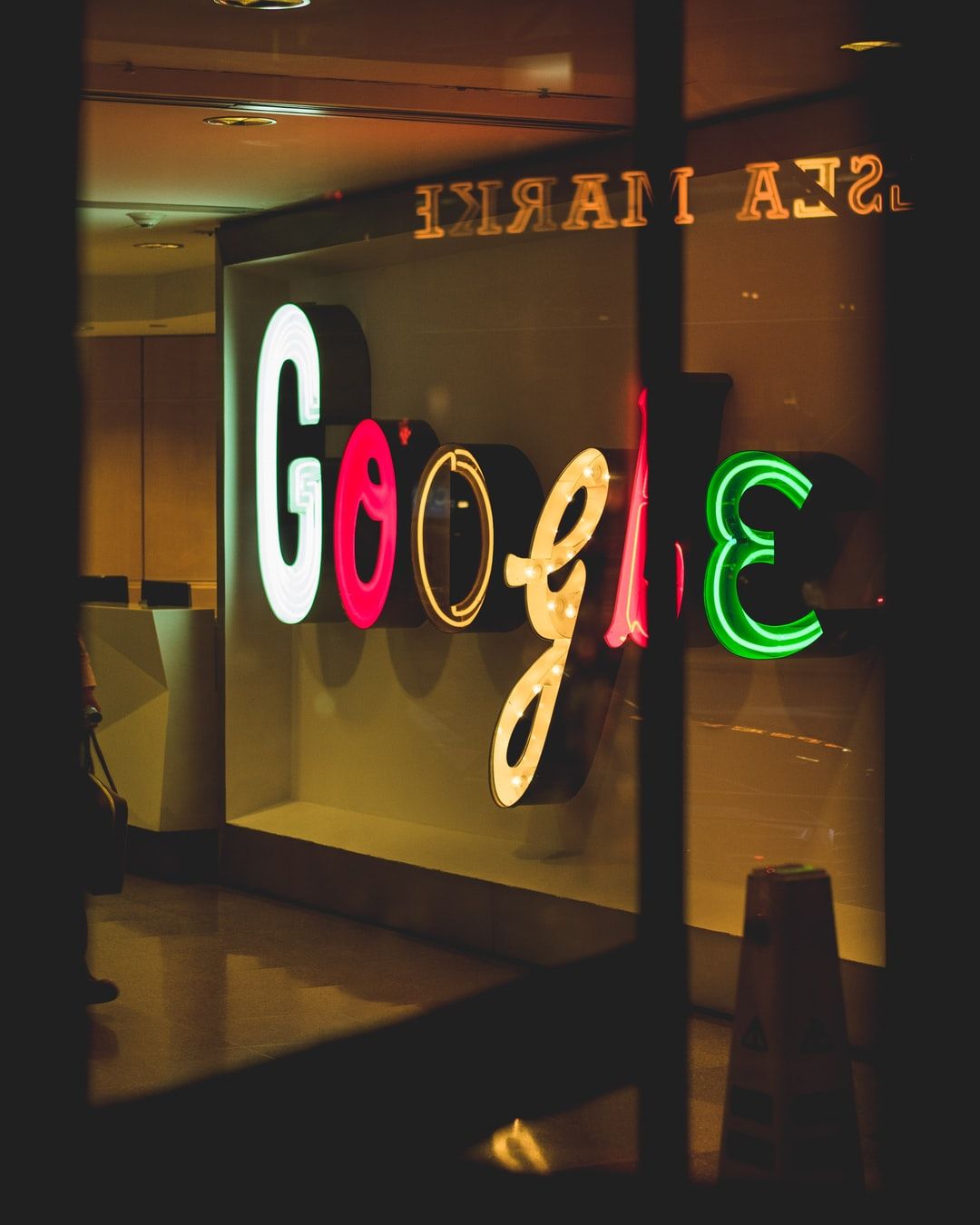Google Ads can give you nearly-instant results. You can get up and running in less than an hour and, there's nothing stopping you from landing a sale at the end of that first hour.
Google Ads is a Pay-Per-Click (PPC) system that places your brand's ad atop search results when people look up information on Google. The key is that these ads are relevant to your products or services.
Another plus: smaller businesses can compete with larger brands on Google Ads. With a few smart decisions and a little bit of investment, they can easily rank at the top of the search engine results pages (SERP). Unlike search engine optimization (SEO) that could take several months or years to rank for a keyword, Google Ads can make a difference in just a matter of minutes.
In this article, we’ll discuss how you can use ads on Google to get more visibility for your business. Here is a clear guide on how to advertise on Google.
What's up ahead:
Part 1: Get Started with Google Ads
- Create your Google Ads Account
- Choose Your Keywords
- Keyword Match Types
- Start with the Best Keywords for Your Campaign
- Write Strong Ad Copy
- Adjust Default Settings
- A word about ad delivery
- Target a location
- Search Partners
- Lesson Learned: Prepare for a Ramp Up Period
- How to See your Ad Data in Google Analytics
PART 2: Improve your Google Ads Campaign
- Expand Your Keywords
- Tools
- Try New Ad Copy Ideas
- Improve Your Quality Score
- Actionable Advice
- Advanced Options
- Optional – Use Google Ads Templates to fast-track your campaign setup
About Google Ads
We love SEO, but that is a slower process. Think of Google Ads as your way to go for more immediate results. Before we jump into the Google Ads tutorial, here are a few stats that highlight the power of Google Ads:
- 49% of shoppers say that they discovered new products and services through Google Ads. (Grow My Ads)
- Businesses generally make an average of $2 in revenue for every $1 they spend on Google Ads (Google)
- That ripples into an estimated $8 in profit from its tie-in to organic results. (Google Methodology)
Google AdWords vs Google Ads
We've said "Google Ads" a few times, and if you came looking for a Google AdWords tutorial, you are in the right place.
In 2018, Google renamed its AdWords platform to be Google Ads. Today, the full Performance Max (PMax) platform helps you advertise through product listings, display, and even video integrations on YouTube.
So while many people are more familiar with "Google AdWords," we will use the name Google Ads from here out.
There will be many lessons in this article that you can carry over to display and video ads. However, the main focus of this tutorial will be Google Ads search campaigns.
Familiarize yourself with the most helpful tips to know before you start a Search Campaign.
How Does Google Ads Work?
Google's advertising system is like an auction, with a few small differences. As an advertiser, you choose any search terms you'd like your ad to appear on, and you set a maximum bid of how much you're willing to pay when someone clicks through on your ad. That's where the term "cost per click" (CPC) comes in.
On that note, let's start with a few important terms:
- CPC: Cost per click. This is how much an advertiser spends from their ad budget when someone clicks their ad.
- Quality Score: This is a measure of relevance to what the searcher was looking for, and it includes your landing page.
- Landing page: A specific page from your website that searchers go to after they click your ad.
Back to the auction. The amount of your bid (compared to others bidding on the same term) will help determine how high up on the page Google places your ad.
In other auctions the highest bidder wins, and the auction ends. With Google Ads, the bids are mostly secret, and the highest bidder doesn't always get the top spot.
Other factors like Quality Score determine which advertiser gets the edge. If your Quality Score is high enough for a certain keyword, Google might not even charge you the full amount of your maximum bid.
Your Quality Score is a combination of how well your landing page matches the search term you're bidding on and how well you can deliver on what the user was searching for.
The more relevant your ad and landing page are to the search, the more likely you are to pay less for the ad and get the click.
Each keyword that you bid on gets its own Quality Score, so you might score higher for some terms than others.
The landing page experience also effects the Quality Score. The landing page should offer an immediate connection to what the user is looking for. Not only should you offer a solution that they want, they shouldn't have to go digging for it.
Your rule of thumb is to match as specifically as possible. Your ad should fit the searcher's intent, and your landing page should back up the ad. Since it takes thousands of variations (somewhat matching a part of their search term or matching a detailed phrase), Google Ads offers ways to automate this and keep it simple.
For example, match types and ad groups help you separate your messages so that they match the user's intent more closely. We'll cover those more in-depth a little further in this tutorial.
How to be Profitable with Google Ads
Google Ads can be a great way to generate revenue for businesses. According to Google, businesses typically make an average of $2 in revenue for every $1 spent on Google Ads. However, simply spending money on ads won't necessarily lead to profits.
Google Ads success is measured in conversions. These are the actions users take after clicking on your ad, such as making a purchase or filling out a lead form. It's great when people click your ads, but the ads only work if you can convert the visitor.
It falls on your landing page to convert visitors. However, your specific ad message is what pulls them in. Your ability to convert visitors to customers happens at multiple points, so you will need to test different ad formats, headlines, and calls to action to see what resonates best with your target audience.
You should also track different conversion rates to see if you're getting a bump with certain products, seasons, or ad groups. Conversions on branded terms are almost always higher than anything else. Don't hold a specific product to the same conversion standards as what you do you branded terms, or you will consider the product to be underperforming.
By tracking your conversions and continually optimizing your campaigns, you can maximize your return on investment and achieve profitable results.
Part 1: Get Started with Google Ads
This will be the biggest segment of the tutorial. You'll create your Google Ads account first, but then there's some preparation to do with keyword research and deciding what makes good ad copy for your product/offer.
Set a Budget
Calculating a Google Ads budget involves mixing information from your sales data with estimated costs from Google. We'll break it down.
Start with the average profit you make from a sale. Let's say it's $100. Advertising takes money, so you'll need to decide how much you are willing to spend out of that $100 to promote your product and pull in traffic. 25%? Done. You have $25 in advertising budget per sale to work with. Now your profit is $75 per sale.
On an extreme scale, we know that your cost per click (CPC) can't exceed $25. That's easy math, but that also assumes that every click ends up in a sale. Since you need a few clicks to your ads before you make a sale (your conversion rate), you need to take that into account.
You are paying for every click even if they don't buy. If it takes 10 clicks to make a sale, and you mentally set aside $25 to pay for those 10, your maximum cost per click is $2.50.
Multiply your ad spend per sale by your estimated conversion rate to calculate a maximum CPC.
$25 x 2% conversion rate = $0.50 CPC
$25 x 5% conversion rate = $1.25 CPC
$25 x 10% conversion rate = $2.50 CPC
As you improve your conversion rate, you have more money to put toward a higher ad position bid. Keep that in mind for future use.
Once you know your maximum CPC, use it to determine your daily budget. When you are just starting out, your conversion rate is a guess. You only need a few clicks to figure out if you need to adjust your CPC up or down. The more data you have, the better decisions you can make. If you get 100 clicks over the first week, that should give you enough data to calculate a more accurate conversion rate. Of course you will tweak this many times as you go, but for now it's a helpful place to start.
If you had a 5% conversion rate, those 100 clicks would have cost you $125 over that week. You would have also made 5 sales with $375 profit.
That example was intentionally basic. Determining the appropriate daily budget for a new Google Ads campaign requires careful consideration of various factors, such as your advertising goals, the target audience, and the competitiveness of your industry.
You may want to start with a relatively small amount per day, say $10, to assess the effectiveness of your ad and gradually increase it as you obtain more data on performance. Remember that the budget should align with your overall marketing objectives and be flexible enough to accommodate changes based on actual outcomes. Therefore, it's important to constantly monitor and adjust the budget, as necessary, to optimize your return on investment (ROI) and achieve your desired results.
Can I Run a PPC Campaign at a Lower Cost?
The cheapest Google Ad setup depends on the industry you're in and the competition level for the keywords you're targeting. The cost per click varies across industries, with some CPCs being as low as a few cents and others several dollars.
A better approach is to aim for stronger ROI– getting more for your money spent--than spending less. You get there through long-tail keywords with lower competition which can help bring down your overall CPC and reduce your advertising costs.
Additionally, optimizing your landing pages and ad campaigns can help improve your Quality Score, which can result in a lower CPC and better ad placement.
Create your Google Ads Account
You can set up your Google Ads account at: https://ads.google.com/home/
They have a guided setup where you answer questions like your email address and website that you will be sending your ads to. You will also set your country, time zone, and currency.
From there, you will need a website or landing pages, keywords, and ad copy to begin. Keywords should be researched and organized into groups to form the building blocks of your ad campaign. Later on in this tutorial, we'll even elaborate on intermediate to advanced keyword strategies and long tail keywords. If you have room in your budget, it's worth taking advantage of Google's support by visiting https://support.google.com/ for different options depending on where you are in the account setup process.
Mostly, the setup is pretty straightforward. There are some options and extensions for your ads that take a little more consideration, and we can walk you through that in the “Advanced” section on this page.
Tip: If your budget allows, take advantage of Google’s support. They have a choose-a-path feature that offers different options depending on which stage you are in with your account: https://support.google.com/
Note that once you have a Google Ads account set up, you can import that into a Bing Ads account as well. That will post your ads on Bing, Yahoo, and AOL searches. bingads.microsoft.com.
Here’s What You’ll Need Before You Start:
- A website (better: landing pages on your website)
- Keywords — search terms you want to advertise on (better: organize those keywords into groups)
- Ad copy and headlines — The messaging of your offer or service
Choose Your Keywords
When you see “keywords” in reference to ads (or maybe “paid keywords” to be more precise,) think of these as the phrases people search in Google, and your ad would appear in front of them as a possible solution.
Keywords will be the building blocks of your ad campaign. You will research them and learn intermediate to advanced keyword strategies in a short amount of time. We'll even elaborate later in this tutorial on long tail keywords, but for now, let's cover the basics.
If a business sold balloons for special occasions, their keywords might include:
- Helium balloons
- Mylar balloons
- Send a birthday gift
- Kids party supplies
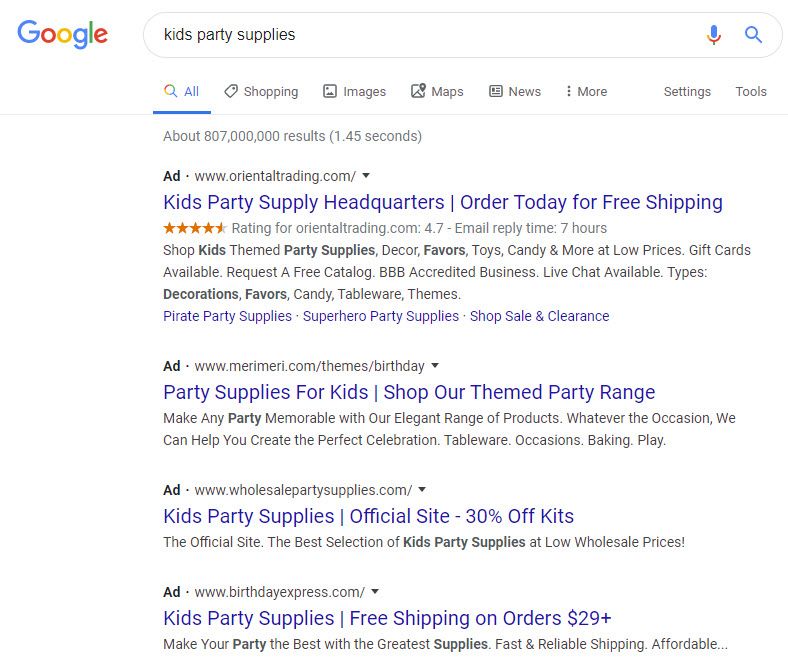
That's the basic premise. But no strong Google Ads campaign runs on just a list of products, because people don't always search that way in Google. You have to use a wider net to catch people who have an idea of what they want, and your services can help. That's where match types come in.
Keyword Match Types
Using the example above, their ads would serve people looking for helium balloons and kids party supplies. There's a lot of territory to cover, though. Translation: a lot of keywords. Our seller might be tempted to cut corners and just go with any "balloon" search. That would be a poor choice. It opens the door to bad matches. Consider this kind of balloon search:
Hot air balloon rides
This has nothing to do with their business, but they would end up losing money on any of their ads that people clicked. Choosing the right keyword match types is a major part of running an effective campaign.
And while you can't predict every possible variation of how people search on Google, you can come pretty close with keywords and how closely their search lines up with those keywords. Check out these different match types and how they work.
Exact Match: [helium balloons]
This should match searches with only this term as you typed it — without additional phrases tacked on before or after. The words have to stay in order.
Returns your ad on searches for helium balloons
Special note: It also returns your ad on “close variants,” and that includes misspellings like helium baloons.
Tip: Keywords are not case-sensitive. Pay more attention to spaces and plurals. Also, avoid non-standard characters like: & @ % *
Phrase match: “helium balloons”
This keeps your phrase together as you entered it (and in order), but other words can come before or after (just not between) your words.
Returns your ad on searches for: buy helium balloons, helium balloons delivered
Special note: Won’t return ads on helium filled balloons
Broad Match: helium balloons
This will return variations (similar to what you saw with exact match), but it doesn’t have the limitations of whatever comes before or after it.
Returns your ad on searches for helium balloons for parties, inflatable balloons
More notes about Broad Match:
- Triggers on queries that Google deems “semantically similar” to your keyword, even if words are out of order or missing.
- Leverages signals like your landing page, ad group themes, and query context to decide when to show.
- Best paired with Smart Bidding and strong negative keywords to prevent irrelevant traffic.
Tip: Build a robust negative-keyword list to exclude unwanted traffic. For example, add -rides, -hot-air, or -DIY if you sell party balloons, not balloon rides or tutorials.
Start with the Best Keywords for Your Campaign
Since you pay for any click that your ad gets, you want to match your ad to the most relevant searches possible.
That takes good keyword research and strategic keyword selection. Here are some tips:
Try the Keyword Planner
Google's original keyword tool helps you find information about search terms like search volume, interest levels by location, and estimated costs. You can use the Keyword Planner for free. To use it, sign in with your Google account, and have a keyword and general topic in mind. The tool will help you grow your ideas from there.
Try a PPC Keyword Tool
While the Keyword Planner has its merits, using it alone means that you miss out on more competitive aspects of keyword research.
When you advertise on Google, you are in an auction, bidding blindly to have your ad appear. Unlike an auction, there are multiple "winners." Your ad will be alongside ads from your competition. That's why it's so important to lean on keyword tools that take competitor information into account.
With a PPC keyword tool like SpyFu, you can take any of these easy approaches to build up your keyword list for a Google Ads campaign:
- Type in a keyword, and find related keywords and ad groups. Use the filters to narrow your list to keywords that match your budget, search volume needs, etc.
- Type in a competitor's domain name to see the keywords they advertise on and how they are organized into ad groups. You can filter those keywords the same way as above and take ideas for your own campaigns.
Additionally, here's a shortcut available in SpyFu. You can use the Google Ads Advisor feature to type in a starting keyword, and we show you shared keywords that similar advertisers have all bought.
And if you already have started a Google Ads account and want to build on the ads you have, we can recommend profitable, effective keywords for your campaign.
Related: Find the Best Longtail Keywords for Your Market
Should I Bid on My Own Branded Terms?
Bidding on your own branded terms is actually an easy win. If you're quickly crossing branded terms off your list to save room for other keywords, go back and reconsider.
It fights off competition.
Once others recognize your brand as a competitor, they will start targeting your keywords. This is especially true if your competition is more experienced. You don't want to leave your brand unguarded. Even if you feel covered with organic results, it's smart here to play it safe.
The ad might even reinforce your organic result.
It's relatively cheap.
Your Quality Score on your own branded terms should be high. Similarly, less competition (compared to high-volume niche terms) means that your cost per click should remain manageable. Combine that mid-to-low range CPC with a high QS and these could be very affordable clicks for you.
Double up the message
Having an ad on your branded terms gives you space to reinforce your message. Your home page is likely to rank for your brand name, so searchers can skim the meta description (or at least the one that Google chooses) before clicking. Your ad lets you control that messaging and get more specific.
Should I bid on my competitor's branded terms?
It's tempting, and there's no clear cut answer. After all, people searching for your competitors by name are more likely to be part of your target market. You might have even seen competitors advertising on your branded terms (more on that in a bit) and stealing clicks and sales.
However, there are cautionary tales about bidding on your competitor's branded terms. Be sure to consider the consequences of advertising on those keywords.
Keep these points in mind
- You cannot include their brand name in the ad copy or headline.
- You might run into retaliation
- Your Quality Score won't be very high, costing you more per click
Fortunately, Google Ads makes it easy to cut your ads immediately if they do pose a problem. If you've weighed the risks and want to test the waters, you should be able to do it without too much risk.
Write Strong Ad Copy
Once you are ready to create your ads, follow these best practices for writing headlines and ad copy.
Today you’ll build your copy inside a Responsive Search Ad. Supply up to 15 headlines and 4 descriptions—Google will mix & match them to find your best performers.
Though Google is helping you to test and find the best ad copy, you need to start with strong ad copy principles. In this next section, we will show you incorporate those best practices into the responsive search ads that you create.
We have a full guide on How to Write Strong Ads for PPC , and we compiled our best techniques into this 2-minute video.
Headlines
You have 30 characters to grab someone’s attention. Your searchers are now “browsers,” skimming the page to see what might answer their search.

Your headline should be attention-getting (but not misleading), relevant, and clear. Every headline has the same single objective: make them read the next line.
Create headlines with the actual searches in mind. It’s tempting to use an umbrella term like “A wide selection of ink toner” for all ink toner products, but you’re missing out on a feature that plays in your favor.
Google often bolds the words in a headline that match what the user searched. If the user searches HP cyan refill, a better headline is “Cyan refills for HP printers.”
Tip: Consider dynamic keyword insertion. It automatically drops the exact keyword into your headline, and it’s best used in your highly-specific ads for products or services that you offer.
When the ad on a “print your own t-shirts” search tells them that they can indeed print their own t-shirts, you can expect a qualified visitor clicking through to your site.
- In RSAs you can enter up to 15 headlines (each 30-char max). Think of each headline as a separate “asset” the system can test.
- Vary your headline value propositions (“Free shipping,” “Next-day delivery,” “20% off bulk orders”) so Google can learn which resonates best.
- If a headline must appear (e.g. your brand name), you can “pin” it to Headline 1—but only pin 1–2 assets. Over-pinning kills mix-and-match testing.
- If you try dynamic keyword insertion, treat that as one of your 15 headline assets.
Descriptions
Be enticing and clear about what you can do for the reader. The team at Google Ads refers to this as the "Description," but when you read about general writing and advertising technique, this is the "ad body."
In RSAs you get 4 description slots (of 90 characters each) to describe your offer.

- Fill all 4 slots with unique calls-to-action or benefits (“Shop now for party supplies,” “See our full color range,” “Order before 2 pm for same-day dispatch,” “Bulk pricing available”).
- Like headlines, you can pin descriptions—but only if an element is legally or brand-required.
When you are setting up your account, be prepared with ad variations for different keyword groups. This might be a product line or different services. For example, your ads for “print your own t-shirts” would be different from your ads for “custom kids t-shirts” since the reader has a specific product in mind.
Landing Page
High-performing ads get customers to your site, and you pay for them whether or not the visitor buys (or signs up). That means to be successful overall, your ads need to point to a strong, relevant landing page that delivers on what the ad promised.
The great thing about the display URL is that it does not have to be the actual landing page URL. You can take advantage of this and use it to your marketing advantage, by creating a display URL like www.mysite.com/keyword-you-searched-for. (Any matching keywords in the URL usually get automatically bolded in the results, too!)
Most sites do keep the same domain in the display URL as in the actual destination URL. It’s a good practice.

If you're looking to improve the design of your landing pages, here are some tips that can help:
Write a powerful headline: Your headline is the first thing that people will read after coming from your ad. It needs to connect clearly to your ad as the solution to whatever they need. Use clear language that will grab their attention and effectively communicate the value of your offer.
Avoid clutter and noise: Keep things focused on your message. Hold back on multiple videos or elements that aren't just distracting but weigh on your page's load time. Let your audience focus on the content and message so you can move them closer to a sale or conversion.
Use straightforward language: Avoid using jargon and complex terms that might not be understood by your audience. Keep things simple, and write as if you're having a conversation with your audience. Unless it conveys clear value, keep it out. Be clear about what you are offering and its value.
Adjust Default Settings
We usually accept default settings as the easiest path when starting something new. In Google Ads, they aren’t always in your campaign’s best interests and could cost you money.
Before you launch a new Google Ads campaign, you might want to turn some of those off (or edit). Here are the most important tips to remember.
Don’t go for the combo deal.
Google suggests that you start with a package deal -- search and display advertising. Start with the Search Network alone. It has benefits built in that give you more control as an advertiser.
The display setting will eat through your budget before you’ve had a chance to find your groove.
Choose "All Features"
Once you select the search network, it turns on the Google Ads Campaign Default Settings. Added-on features like these can cloud the process when you're just starting. We suggest that, here, you turn on “All features.”
This will give you a few more choices that make sense at this stage.
Expand your extension options
The hidden extensions are a bit more advanced and probably used more once you’ve got a campaign underway. I can see Google’s reason for cutting potential distractions, but they might be a good fit for you. Decide for yourself. These are the options you would otherwise miss:
- App - This shows up on mobile and tablet searches, letting you connect your ad to your app.
- Reviews - Your ads can include customer feedback from 3rd party review sites.
- Callouts - This is additional information to highlight a unique service like “free shipping” or “price matching.”
- Structured Snippets - Pull details about a product or an offer from your landing page into your ad.
- Site links extensions offer extra real estate for your ads and help your ads stand out a bit more. Also, they provide links to possibly more relevant content.
How do you add ad assets to your Google Ads campaigns?
To attach assets—like sitelinks, callouts, or structured snippets—to your ads, head to the left-side menu in your campaign dashboard and look for the “Assets” tab. Click on it, and Google will walk you through the available options, letting you pick those that best showcase your business. Just follow the prompts to add details and assign them to your chosen campaigns or ad groups.
Take a moment here to experiment—these little add-ons can make your ads a lot more appealing and help you stand out among all the noise.
Advanced settings
Here are more options that come available when you turn on “all features.”
- The schedule setting is a budget stretcher. It helps you reach people at the right time. It also starts and ends your campaign if you need to run your ads across specific dates.
- Ad delivery--You can run multiple ads for the same search. It lets you try new messaging or spread out what you want to say. (See more details below.)
- Dynamic search ads--This is a unique setting for websites that may have different pages promoting the same or similar products/services. (Bed Bath & Beyond might have pages for Dorm Room Needs and then for Luxury Bedding with both of them offering sheet sets.) Google Ads will serve up pages that it thinks are most relevant to the user's search.
- Responsive search ads--You'd pack the possible headlines and descriptions for an ad and give Google the flexibility to serve up different combinations. This can help you reduce the number of ad groups you manage, by allowing Google to pick the ad copy that works best for each user.
- Campaign URL options--Give you flexibility to add tracking codes to your URLs.
A word about ad delivery
There is some tricky language in the ad delivery options that could give you a false sense of confidence.
- Optimize uses Google’s ML to favor ads with higher CTRs and conversion rates. It’s great if you want the platform to dynamically allocate budget where it “thinks” you’ll get the best ROI.
- Rotate indefinitely gives every ad equal auction weight, so you’ll see unbiased delivery across all your headlines and descriptions. If you’re running promos, distinct offers, or radically different messaging, choose Rotate indefinitely to gather clean performance data.
Unless you have a short amount of time to manage this campaign, choose "Rotate Indefinitely" over the Optimize option. Using an automated system is tempting, but you need objective data to really know what is working well. Remember, testing is crucial to your business success.
By default, the platform generally prefers the best-performing ads. On the surface, that sounds like a win—you’d expect to get the most out of your budget with whatever ad gets chosen. But here’s the catch: if you let the system auto-optimize from the start, you may never learn the nuances about what actually works best for your unique audience.
If you’re interested in truly testing ads against one another—especially if you have different types of copy or offers that you want given a fair shot—choose "Rotate Indefinitely."
Since “Rotate indefinitely” can make analysis cumbersome at scale, many advertisers now use the Drafts & Experiments feature to run true A/B tests—setting up split-traffic experiments, measuring lift, and then applying winners with confidence.
Once you have enough data, you can confidently choose a winning message and lean in, knowing your decision is based on actual performance, not just algorithmic hunches.
Target a location
The default setting captures a broad group. If you have location-based products or services, a targeted location is a good way to save money from clicks that aren’t likely to convert.
If you don’t want to show ads to anyone outside of your geographic coverage area, be sure to choose “people in my targeted location.”
Don’t scroll past this one. It’s shown as “Location Settings (Advanced).”
Device Targeting
Device targeting in Google Ads lets you decide exactly where your ads appear—think desktops, tablets, or mobile phones. This flexibility is valuable since your audience’s behavior changes along with their device of choice. For example, folks researching home décor on their laptops might be in information-gathering mode, while someone browsing vacation rentals on their phone during a lunch break could be ready to book.
Why put this tool to use? Because not all clicks deliver the same value. With manual bidding, you can adjust your bids for each device type—raising your bid for high-performing devices or turning down (even excluding) those that aren’t converting. If your data shows mobile users are all window shopping and never checking out, it may be time to press pause on mobile placements until you have a clearer picture.
Quick tip: For Search campaigns, you can modify how much you bid for traffic from different devices. For Display, you’ll find an easy checkbox option in your settings. No matter your campaign, be sure to check the Devices section in Google Ads to track what’s working and tune your strategy.
The bottom line: Lean into the data and stay flexible. Testing various device strategies is a key part of what makes your campaigns smarter—and your budget happier.
Understand Who Search Partners Are
Google turns on “Search Partners” by default. It’s important that you learn more about where your ad might appear outside of a Google search result page.
Other than YouTube, Google doesn’t clearly state the full list of their search partners, but it mentions that there are hundreds of qualifying sites. That includes sites that use the Google search tool on their page as well as other search engines like AOL and Ask.com.
That expands the potential reach of your ads, and click through rates on those sites do not affect your overall Quality Score. However, Google leaves room for adjustment when it states that your ad might appear on "other pages related to the person's search."
Google continues to update and grow its ad platform, so--even if you are creating your third, tenth, or 20th campaign--review the default settings with a bit of scrutiny. They aren’t always in your campaign’s best interests.
How Should I Structure My Campaign?
When it comes to structuring your Google Ads account for optimal performance, there is no one-size-fits-all solution. However, there are a few popular strategies that you can consider:
Build Campaigns on Match Types
By setting ads and landing pages for Broad, Phrase, and Exact matches, you can track the performance of specific keywords and adjust your budget accordingly.
Group campaigns around specific products or brands.
This method can streamline your account organization and allow you to quickly allocate resources to specific areas of your business.
Single keyword ad groups (SKAG).
Each ad group is dedicated to a single keyword, which allows for more granular control over ad settings and performance tracking. However, it can be a lot of work to set up and manage, especially if you have many keywords.
It may take some trial and error to find the optimal approach, but working with your options can help ensure that your ads are reaching the right audience and driving results.
Lesson Learned: Prepare for a Ramp Up Period
Here's a real-life scenario. It seemed like Google never even wanted our money. We chose keywords and put together ads, set bids and pushed the magic button. And then very little happened.
It's not as though nothing happened. Had that been the case, we would have looked for what was broken. Instead, flat activity on our ads just reinforced our (wrong) assumption that this wasn't going to bring in much business.
Clearly, this quick break from instruction is going to veer into a story, but I promise it's as valuable as any other part of this Google Ads tutorial. Especially if you are just starting a PPC campaign, this info is vital.
When you first start a Google Ads campaign, you will need to account for a "ramp up" period. It takes a good month to reach stable, testable results.
Some businesses may start seeing results within a few days, while others may need to wait a few weeks or even a month before noticing any significant changes. It's important to be patient and not give up too soon.
In SpyFu's early days, we ran a few AdWords text ads and sprinkled in some display. The biggest surprise was how little we ran through our budget. In our eyes, there just weren't enough clicks to be had. What we didn't realize was that Google was cautiously testing us.
Once an experienced CRO (conversion rate optimization specialist) took the reins on our PPC campaign, we saw a major turnaround. He pushed hard on our budget and increased spending like flooring the gas pedal in a car. That flipped the switch.
What's going on?
During the first 2-4 weeks of any new campaign, Google is watching how your ads match the traffic they send to you. You don't have enough history yet to show a reliable click-through rate or a bounce rate, and Google leans on those metrics to determine if you're relevant enough to earn more traffic.
It's a good move for Google to protect itself and others in the mix:
- This protects existing advertisers so they don't lose out on relevant clicks
- This protects searchers from an onslaught of flash-in-the-pan ads
- This protects you from runaway ads that cost you money without converting
Our Advice--Stay Focused
Don't take it personally. With an optimized campaign built on strong, relevant keywords and ad copy, you'll get past this obstacle easily. There are a few things you can do to speed that up.
Budget is key.
Power up your first two weeks by spending at a higher rate than what you would have planned--both in total budget and in cost per click. Google is testing your ads and making sure that you won't just fizzle. Their objective is to put the most relevant ads in front of searchers, so the more they can serve your ad, the better. This time frame (2-4 weeks) depends a bit on your daily budget. Lower budgets might stretch this out.
Also, don't forget that smart competitors have you on their radar. By watching for emerging competitors they can easily adjust their bids up to keep from losing impression share and clicks to your new campaign. This isn't the time to hold back on your bid amounts.
Eliminate low performing keywords.
At this point, you need to run a lean campaign. Any fluff will drag you down. Take out keywords that aren't getting many searches, and pull the ones that hardly get clicked as they will count against you.
Reconsider your ad copy.
If your lower performing keywords are strong for your competitors and match your business, your copy could be at fault. Review the dominant message and tone that works well for your competitors, and update your copy with a stronger, clearer call to action.
Troubleshooting
What happens if your ads are limited or disapproved in Google Ads?
If you suddenly notice that one (or more) of your ads is showing up as "limited" or "disapproved," don't panic—this isn’t unusual, especially when you’re fine-tuning and testing new campaigns.
First, every ad you launch is run through Google’s automated review system. If there’s a problem, you’ll spot it on the status column right next to your ad. Take a look at the listed policy or warning message. Many times, fixes are straightforward: maybe a stray exclamation point, or some wording that doesn’t quite fit Google’s editorial guidelines. Just edit your ad copy, resubmit, and you might see it go live almost instantly.
But from time to time, even totally compliant ads can still get flagged by mistake. If that happens, or if you’re facing a trickier policy violation you don’t understand, hover over the status alert and look for the appeal option. Fill out the quick form and request another review. This kicks off a manual check, and if you’ve addressed the issues (or there weren’t any in the first place), Google will usually restore your ad without much fuss.
Be patient! Don’t let the occasional disapproval rattle you. Google is motivated to get you back and running too.
How to See your Ad Data in Google Analytics
If you connect your new Google Ads account to your Google Analytics account, you can measure and improve your ad performance. It lets you import metrics like bounce rate and pages per session into your Google Ads account, and it opens the door to remarketing campaigns.
Follow these steps to link your accounts:
Log in to both Google Analytics and Google Ads with the same email address (that you use for both accounts).
You'll need the proper access for both tools:
For Google Ads, you need admin level access. Go to Tools and Settings > Account Access to confirm.
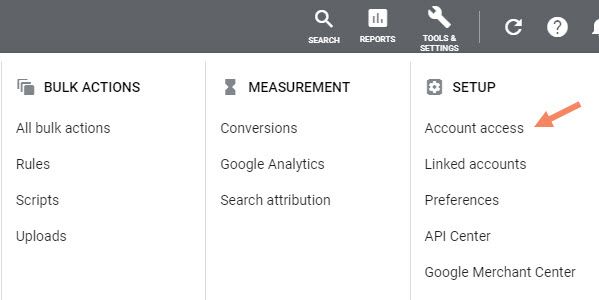
For Google Analytics, you need Edit permission.
According to Google, you don't need these permissions permanently. "These permissions are only required for the linking process. After you've created the link, the permissions can be modified or removed entirely."
In Google Analytics, open Admin>Property User management. You need to have at least Edit, Read & Analyze access.

While still in Google Analytics, return to the Admin view and look down to the Product Linking section below "Property."
Choose "Google Ads linking."
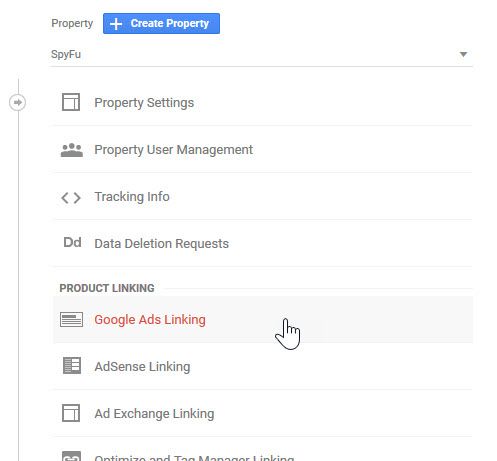
As long as you're logged in, you should see your Google Ads account ID carried into the list with a check box. Check the box and continue.
Name your account (using Link Group Title) and choose the views that you'd like to pull data from.
Tip: Autotagging is an option for a more turnkey approach, but we leave this unchecked. That allows us to rely on UTM codes that give a little more customization and control over what you see inside the analytics results.
Finally, click "Link Accounts" to finish.
PART 2: Improve your Google Ads Campaign
Expand keywords by reviewing what works for your competitors
Your competitors have already road-tested an approach with the same audience you’re targeting. Learn what worked and also from what didn’t.
Watch for patterns and consistency. When a competitor runs an ad on a keyword, that’s notable. When that same competitor bids toward the upper range for this keyword and does so month after month, that tells you that the keyword is promising. Pay attention to the keywords they buy repeatedly–as well as the ad copy they run with it.
To find your competitor's keywords that they advertise on, type the domain name into SpyFu's search bar, and look for "PPC Research." The menu gives you an option for "PPC Keywords," and that will list every keyword search we've seen your competitor advertise on.
You can filter the list to get a closer match of keywords that work for you. This might be keywords at a certain cost or search volume. Or make it word based. You can filter by the words themselves. Once you've crafted your list you can export it to save that list and keep exploring other options.
From here you can click through any single keyword to get more focused details about its overall ad activity. We also like branching off into the Related Keywords option. Those can gives you new ideas for relevant ads that you hadn't considered.
Tip: Here are 6 ways to create an effective Google Ads strategy
Advertise on long tail keywords
Once you establish core topics that work for you, it’s time to explore longer search phrases that stem from them. Use your more successful keywords and brainstorm ways that people would ask specific questions about them. Use locations and situations for inspiration.
| Core Keyword | Long Tail Suggestion |
|---|---|
| Find a plumber | Licensed plumber for water heater repair |
| Screen shot software | Screen shot software for iPad |
| Photography | Online digital photograph course |
Using long tail keywords gives you a 3-step boost:
- The visitor is already tuned in to what you’re offering.
- You can be ultra-specific with your landing page, giving your Quality Score a boost.
- Strong QS leads to lower CPC and better ad position, which means more clicks for less money.
Tools
There are keyword tools to help you find more effective long tail keywords for your campaign. We’ve listed a few.
Type a ”starter keyword” idea into SpyFu’s search bar and select the Related Keywords tab. SpyFu finds the results from competitors who buy the core keyword and then pulls similar keywords that those sites buy month after month.
Start with a root word like “coffee” and the tool serves up longer variations that might inspire new keyword ideas for you, like “coffee shops near me.” You can ask the tool to suggest keywords tied to universal search types like images, shopping, YouTube, and news.
Similar to SpyFu, enter a keyword and get new ideas for expanded, similar terms. It returns low-detail results to help limit distractions.
Google Auto Suggest
Type some of your keywords into Google, and note the phrases that Google suggests. These suggestions are updated in real time and are based on actual user searches, helping your chance at generating traffic.
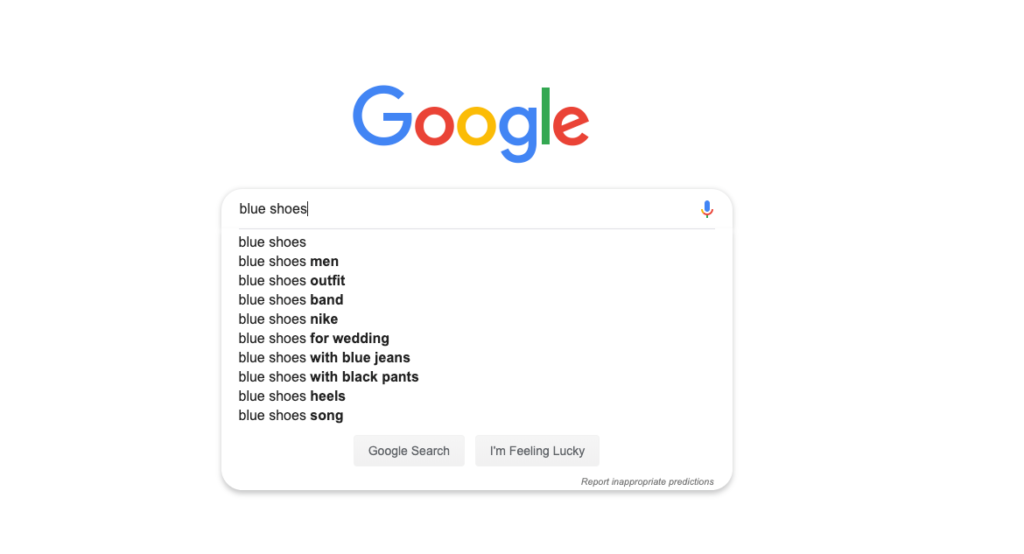
Try new ad copy ideas
Have you updated your ad copy since you launched your campaign? If not, small tests can pay off big. Not only does optimized ad copy drive more people to your site (per ad), but a better click through rate leads to higher Quality Scores. (More on that in the next section.)
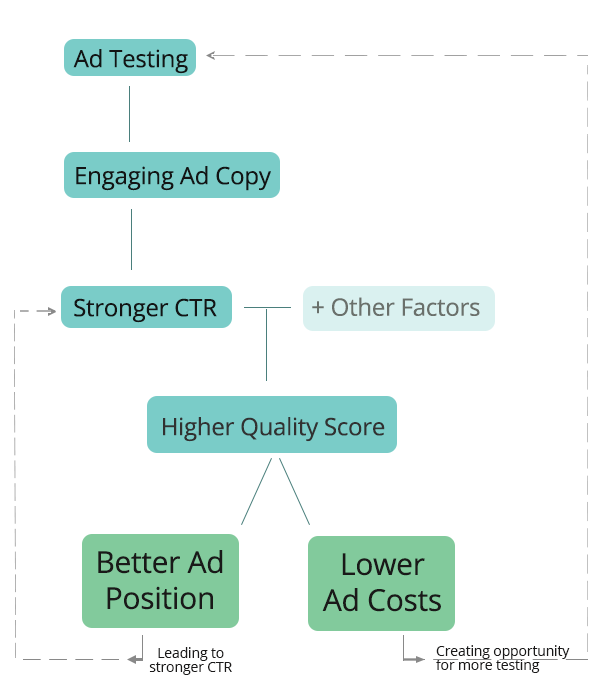
Let your current standings guide you:
- Set a benchmark with every version of your ad copy.
- Compete against yourself. Try to improve your performance over where you are now. Don’t worry about click rates that other businesses or industries get. Start with small wins and build from there.
- Come up with variations/changes that are still relevant to that ad group or keyword.
Measure more than just traffic counts.
Be sure to measure wins by their bottom line. In other words, just because ad variation A gets more clicks, ad variation B may get more conversions. And, just because ad variation B gets more conversions, ad variation C may account for higher-dollar sales.
When possible, always measure performance by ROI, or more common among advertisers: ROAS (return on ad spend). You have to spend money (and other resources like time, account management, etc.) up front. That's your investment. The net profit that you get back is your return on investment, ROI.
A higher ROI indicates a more effective use of the investment. ROI is commonly used in business as a measure of how well an investment is performing or as a tool to compare different investment options. In the context of Google Ads, ROI can be maximized by adopting strategies such as dynamic keyword insertion and improving upon tested ad copy. This can result in significant returns on investment.
Improve Your Quality Score
When you use keyword tools to estimate a search term's CPC, those costs will be estimates. The amount paid varies from one advertiser to another based on many factors like their ad position and how relevant their landing page is.
Google assigns a Quality Score to your ads to determine how much you will pay for any clicks--even though you've placed a bid.
- Your Quality Score affects your cost-per-click (CPC).
Your Quality Score is a number 1-10 and is determined by your ad relevance, landing page experience, and expected click-through-rate (CTR).
If you can improve any of those three, you can move your Quality Score in the right direction, helping to reduce your overall ad costs. You will have more control over your ad relevance and landing page experience.
Improve your ad relevance by using targeted, helpful ad copy for tight ad groups. Your landing page should reflect what you described in your ad and give the visitor clear direction on how to find what they searched for.
Look at it as an incentive from Google to make your ads and landing pages as relevant to the search as possible. The better they match, the less you might pay. It's a huge oversimplification, but it's helpful direction.
Because while you can get into details of how Google arrives at Quality Scores and Ad Rank, it's important to streamline it in this beginner's guide to Google Ads. This isn't the time to derail you. If you'd like to explore some descriptions, look at Google's explanations of Quality Score, Ad Rank, and their differences.
We should also mention that like with your ads, you should expect to update and optimize your landing pages over time. There are several tools available. Try website builders like Instapage and Unbounce. Both offer a large selection of templates that are easy to customize and are made for conversions.
Actionable advice
Once your Google advertising campaign goes live, keep track of how each keyword is performing. Identify keywords with low scores and see if you can increase their relevance. If you can’t find a way to optimize them, it might be best to delete them and try new keywords.
By turning off ads that are not driving conversions, you can focus your budget on the ads that are performing well. Adding more relevant keywords can also increase your ad's exposure and relevance, leading to more clicks and conversions.
Focus on your score for high-intent keywords. This doesn't always mean "high volume." As we've seen with keywords like "3M Headquarters," Google will show St. Paul MN in the results to satisfy the search. There's not much that people need to click if that's the answer they were hoping to find. High-intent keywords tie to searches where the user is ready to take action by clicking a link.
Advanced Options
Extensions
Extensions are optional features you can turn on that give your ad more options. They can give the reader your phone number or location. Or, they can show different site links that that you want searchers to see (like About Us, Schedule an Appointment, or Menu).

There are also automated extensions that pull in site reviews and ratings.
Tip: Along with the cost per click for an ad, you might pay for a click on certain extensions like downloads and calls. Additionally, your ad must meet a minimum Ad Rank to qualify for extension use.
Your Ad Rank is the combination of your bid and the quality of your ad and landing page.
Dayparting
This lets you set your ads to run only during set times of the day. Dayparting, when done well, helps you target your customers when it makes the most sense, and it could drop your ad costs. This might be ads for a lunch special between 11 a.m. and 2 p.m. or ads for a weekends-only promo that points to a time-sensitive landing page.
Tip: Find this in Google Ads as a “custom schedule” or an “ad schedule” in the Settings tab.
Remarketing
A visitor comes to your site and browses your sunglasses page. They move on to other websites, and your ad for the same tortoise shell sunglasses that they saw appears while they’re reading a news article or scrolling through videos.
That’s remarketing in action. You can set it up for your display ad to appear on another site through the Google Display network or as a text ad through the Google Search Network.
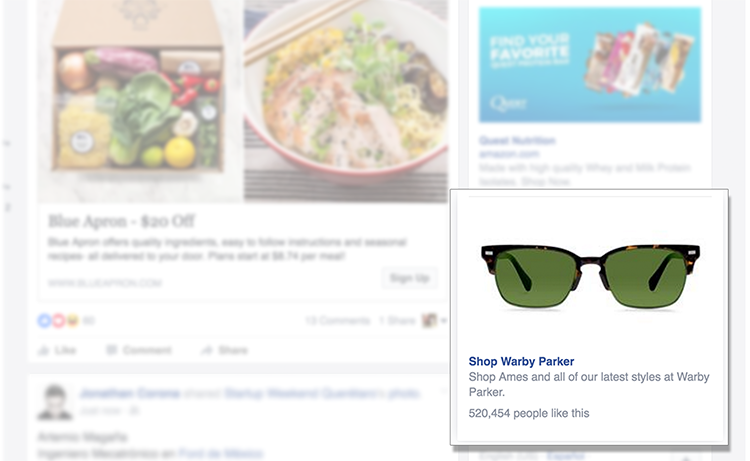
Tip: You will need to get a snippet of code from Google Ads and place it on your site. Then, set up lists so that Google knows exactly what the visitor has to see or do on your site before it triggers your ad on another page.
Dynamic Keyword Insertion
As mentioned before, using dynamic keyword insertion lets you instantly customize the ad to match what the visitor was searching.

You can dynamically insert the search term into the headline or into the ad copy itself.
A word of caution: scour your match types on these keywords carefully, because if you don’t offer exactly what they searched, your ad ends up wasting you a click and frustrating a potential customer.
Example: Phrase matching “soccer cleats” with a dynamically inserted keyword can show up on a search for “youth soccer cleats.” If you have only adult sizes, this isn’t a good ad.
Optional – Use Google Ads Templates to fast-track your campaign setup
If all of this seems overwhelming, don't let it keep you from reaping the benefits of a Google Ads campaign. In fact, advertising on Google is pretty straight-forward. So much so that we were able to create some templates that can fast-track your starting process.
The templates are available for download through SpyFu. They act as guides to help you launch a campaign, and each one is customizable.
What’s in the template?
One of the hardest parts of advertising online might be solved with a ready-made Google Ads campaign. Having already-built PPC campaign templates lets you fast forward through the set-up.
Deciding to launch a Google Ads campaign is the easy part. It’s tougher to actually get it running. After brainstorming and researching keywords, you might be looking for reassurance that you’re investing in the right ones. Then, you’ve got to group them and write relevant eye-catching copy and bid competitively without losing too much of your budget.
SpyFu’s multiple tools help PPC managers with all of these steps, but we realize that the project can feel daunting. That’s where these Google Ads Templates can help.
At SpyFu, we don’t run PPC campaigns for customers, but we do study millions of them and we’ve created PPC campaign templates from this data. All of that research and knowledge tells us that there are a few components we could fine-tune and put into production.
We rolled those ideas into the design of our Google Ads Templates tool.
Our Google Ads campaign templates are created by our expert team. They act like a starter kit that you can take and apply to your business. You can choose your industry from our list and get your PPC campaign up and running within minutes.
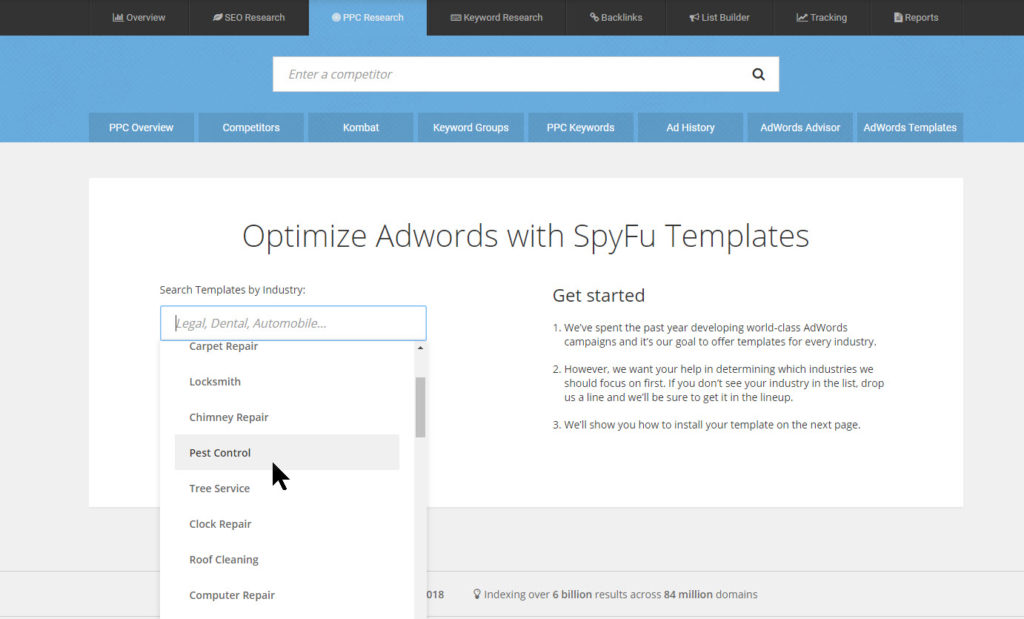
The template is a file that includes pre-written ads for the most strategic keyword groups in that specific industry. What you get for “Pest Control” will be very different from what you’d get for “DUI Lawyer.”
Each template lets you set up a full, ready-to import Google Ads campaign. The PPC templates include:
- Relevant keywords for that industry, set to exact match
- Bids — the price you plan to pay for each click — based on SpyFu competitive keyword data
- All keywords organized into ad groups
- Attention-grabbing ads: headline and copy for each ad group
How does it work?
Go to the Google Ads Templates tab on SpyFu.com. Select an industry from our drop-down list, and we’ll immediately start the download. (Look for it in your downloads file or on the downloads bar.)
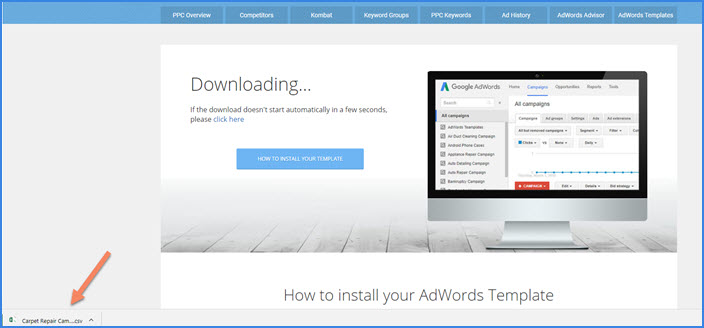
All you have to do with the template is save it so you can import it into the Google Ads Editor. The Editor will read the file to fill in the blanks as though you’ve spent hours building a campaign.
Do I need any special software to use it?
- Google Ads Editor
- An active Google Ads account
The template itself is a CSV file (a lot like an Excel spreadsheet), but you only need to save it. You will need to download the Ads Editor from Google in order to put the template’s data to work.
Can I make changes?
Yes. The template gets you started, and you add the final touches before making it live. You’ll need to make basic changes like updating the URL for each ad. You can customize the campaign further like adding branded keywords and product keywords with their own ads.
It’s also important that you review the preset bids (and adjust if necessary). These are made to be competitive but skew low. We believe that you should be testing and updating your bids, so we give you room to move up. Overall, it’s important that they fit your budget.
The campaign doesn’t go live until you decide it’s ready. You’ve got total control over the keywords that you advertise on, how much you will bid for each one, the wording of the ads, and even the date that the ads start running.

You can do as much as you’d like to customize the campaign.
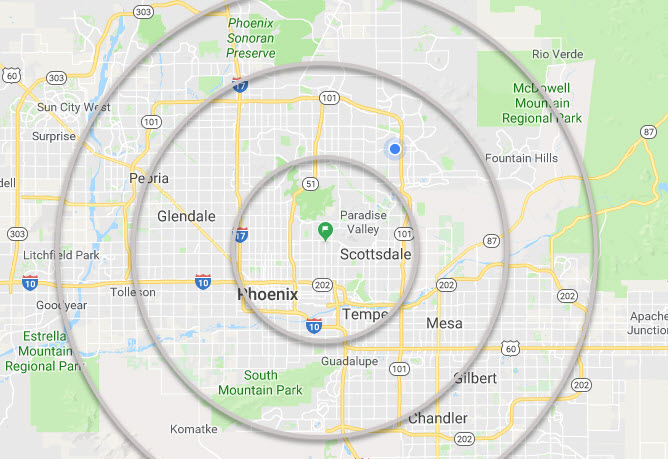
Make as many edits as you’d like or keep it simple. Even taking just 5 minutes, you can get a new Google Ads campaign off the ground without the tedium or headaches that go with it.
We’ve made them easy to use. There are instructions on the page to guide you along and offer any explanations you might need.
If you don’t see your industry, you can submit a template request and we’ll work on getting that built.
Wrap Up – You're Ready to Go!
When people search on Google, they’re looking for something specific. They are searching with intent, they are heading to Google to find solutions for their problems. You have solutions. It's just a matter of matching with the right search at the right time.
At this point, you have the tools to start. You can wipe away any hesitation as the speed and nature of PPC lets you react to any parts of your campaign that aren't working and correct the issue immediately. Test and learn from what you found. Then, repeat the cycle.
If you want to take your training further, though, there are multiple PPC training courses--either from Google or from 3rd party experts--that help you dig deeper into Google Ads.
